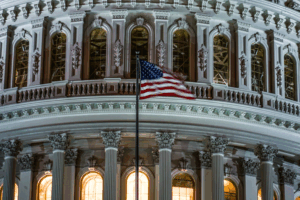
It’ll be a Red-Hot Tariff Summer?
Mark Lightner, Esq. - Head of Special Situations Legal Research, CreditSights
11 June 2025
Insights into Tariff Litigation and Its Impact on U.S. Trade Policy
- Federal Circuit’s Stay Explained: Understand the implications of the U.S. Court of Appeals for the Federal Circuit’s decision to pause lower court rulings against Trump’s tariffs.
- Anticipated Appeal Outcomes: Learn about the expected timeline for federal appellate court decisions and their potential impact on tariff enforcement.
- D.C. Circuit’s Supporting Role: Discover how proceedings in the U.S. Court of Appeals for the District of Columbia contribute to the broader tariff litigation narrative.
- Macroeconomic Effects: Analyze the potential economic consequences of ongoing tariff disputes and the uncertainty they create for trade negotiations.
- Future SCOTUS Involvement: Explore the likelihood of Supreme Court review and how it could shape the future of U.S. trade policy.
Executive Summary:
- On June 10, 2025, the U.S. Court of Appeals for the Federal Circuit formally stayed (i.e., paused) the sweeping decision issued by the U.S. Court of International Trade striking down several of President Trump’s tariffs.
- The Federal Circuit’s stay will remain in place while it considers the government’s appeal more broadly, and oral arguments are tentatively scheduled for July 31, 2025.
- A similar saga is unfolding in the U.S. Court of Appeals for the District of Columbia, where a stay is currently in effect following a decision by the D.C. District Court striking down the tariffs.
- We anticipate that the federal appellate courts will move quickly, potentially issuing decisions on the merits by late August or September 2025 in the most expedited scenario, and we expect tariff-related cases will likely reach SCOTUS next term.
- This note provides background on the key lower-court decisions, discusses the government’s attempts to stay those decisions, and offers our expected timeline for resolution on appeal.
- Regardless of the appeals’ trajectory, it will likely to be a red-hot tariff summer, as the orders enjoining the tariffs are unlikely to take effect anytime soon.
Introduction
We have written extensively on litigation challenging Trump’s tariffs, and we assume general familiarity with the legal issues and those cases. See generally U.S. Trade Court Shoots Down Trump’s Tariffs; U.S. Court Grapples with Liberation Tariffs; Trump 2.0 at 100 Days: Legal Perspectives (Part 1); Tariffs: California to the Rescue?. This note provides an update on that litigation following the decision by the U.S. Court of Appeals for the Federal Circuit (the “Federal Circuit”) staying (i.e., pausing) the lower court’s ruling invalidating Trump’s tariffs. Specifically, this note provides background on the key lower-court decisions, discusses the government’s attempts to stay those decisions, and offers our expected timeline for resolution on appeal.
Background on Key Lower Court Rulings
As we discussed in U.S. Trade Court Shoots Down Trump’s Tariffs, on May 28, 2025, the U.S. Court of International Trade (the “Trade Court”) unanimously struck down President Trump’s so-called trafficking, worldwide, and retaliatory tariffs, including the Liberation Day Tariffs, in two cases styled as V.O.S. Selections, Inc. et al. v. Trump et al., No. 25-00066, and State of Oregon et al. v. Trump et al., No. 25-00077 (see ruling here). The Trade Court—which is a U.S. federal court—issued a sweeping decision that vacated the following tariffs in their entirety and enjoined their enforcement as to all importers:
Executive Order 14193, Imposing Duties To Address the Flow of Illicit Drugs Across Our Northern Border, 90 Fed. Reg. 9113 (Feb. 1, 2025);
Executive Order 14194, Imposing Duties To Address the Situation at Our Southern Border, 90 Fed. Reg. 9117 (Feb. 1, 2025);
Executive Order 14195, Imposing Duties To Address the Synthetic Opioid Supply Chain in the People’s Republic of China, 90 Fed. Reg. 9121 (Feb. 1, 2025); and
Executive Order 14257, Regulating Imports with a Reciprocal Tariff to Rectify Trade Practices that Contribute to Large and Persistent Annual United States Goods Trade Deficits, 90 Fed. Reg. 15041 (Apr. 2, 2025).



